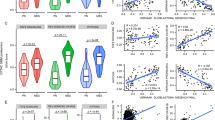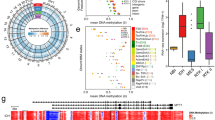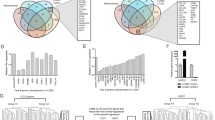Abstract
The inference of transcriptional networks that regulate transitions into physiological or pathological cellular states remains a central challenge in systems biology. A mesenchymal phenotype is the hallmark of tumour aggressiveness in human malignant glioma, but the regulatory programs responsible for implementing the associated molecular signature are largely unknown. Here we show that reverse-engineering and an unbiased interrogation of a glioma-specific regulatory network reveal the transcriptional module that activates expression of mesenchymal genes in malignant glioma. Two transcription factors (C/EBPβ and STAT3) emerge as synergistic initiators and master regulators of mesenchymal transformation. Ectopic co-expression of C/EBPβ and STAT3 reprograms neural stem cells along the aberrant mesenchymal lineage, whereas elimination of the two factors in glioma cells leads to collapse of the mesenchymal signature and reduces tumour aggressiveness. In human glioma, expression of C/EBPβ and STAT3 correlates with mesenchymal differentiation and predicts poor clinical outcome. These results show that the activation of a small regulatory module is necessary and sufficient to initiate and maintain an aberrant phenotypic state in cancer cells.
This is a preview of subscription content, access via your institution
Access options
Subscribe to this journal
Receive 51 print issues and online access
$199.00 per year
only $3.90 per issue
Buy this article
- Purchase on Springer Link
- Instant access to full article PDF
Prices may be subject to local taxes which are calculated during checkout





Similar content being viewed by others
References
Ohgaki, H. & Kleihues, P. Population-based studies on incidence, survival rates, and genetic alterations in astrocytic and oligodendroglial gliomas. J. Neuropathol. Exp. Neurol. 64, 479–489 (2005)
Demuth, T. & Berens, M. E. Molecular mechanisms of glioma cell migration and invasion. J. Neurooncol. 70, 217–228 (2004)
Kargiotis, O., Rao, J. S. & Kyritsis, A. P. Mechanisms of angiogenesis in gliomas. J. Neurooncol. 78, 281–293 (2006)
Phillips, H. S. et al. Molecular subclasses of high-grade glioma predict prognosis, delineate a pattern of disease progression, and resemble stages in neurogenesis. Cancer Cell 9, 157–173 (2006)
Tso, C. L. et al. Primary glioblastomas express mesenchymal stem-like properties. Mol. Cancer Res. 4, 607–619 (2006)
Takashima, Y. et al. Neuroepithelial cells supply an initial transient wave of MSC differentiation. Cell 129, 1377–1388 (2007)
Wurmser, A. E. et al. Cell fusion-independent differentiation of neural stem cells to the endothelial lineage. Nature 430, 350–356 (2004)
Rhodes, D. R. & Chinnaiyan, A. M. Integrative analysis of the cancer transcriptome. Nature Genet. 37 (suppl.). S31–S37 (2005)
Basso, K. et al. Reverse engineering of regulatory networks in human B cells. Nature Genet. 37, 382–390 (2005)
Chen, Y. et al. Variations in DNA elucidate molecular networks that cause disease. Nature 452, 429–435 (2008)
Margolin, A. A. et al. ARACNE: an algorithm for the reconstruction of gene regulatory networks in a mammalian cellular context. BMC Bioinformatics 7 (suppl. 1). S7 (2006)
Margolin, A. A. et al. Reverse engineering cellular networks. Nature Protocols 1, 662–671 (2006)
Zhao, X. et al. The N-Myc-DLL3 cascade is suppressed by the ubiquitin ligase Huwe1 to inhibit proliferation and promote neurogenesis in the developing brain. Dev. Cell 17, 210–221 (2009)
Lim, W. K., Lyashenko, E. & Califano, A. Master regulators used as breast caqncer metastasis classifier. Pac. Symp. Biocomput. 14, 504–519 (2009)
Mani, K. M. et al. A systems biology approach to prediction of oncogenes and perturbation targets in B cell lymphomas. Mol. Syst. Biol. 4, 169–178 (2008)
Palomero, T. et al. NOTCH1 directly regulates c-MYC and activates a feed-forward-loop transcriptional network promoting leukemic cell growth. Proc. Natl Acad. Sci. USA 103, 18261–18266 (2006)
Taylor, R. C., Acquaah-Mensah, G., Singhal, M., Malhotra, D. & Biswal, S. Network inference algorithms elucidate Nrf2 regulation of mouse lung oxidative stress. PLoS Comput. Biol. 4, e1000166 (2008)
Hanauer, D. A., Rhodes, D. R., Sinha-Kumar, C. & Chinnaiyan, A. M. Bioinformatics approaches in the study of cancer. Curr. Mol. Med. 7, 133–141 (2007)
Lander, A. D. A calculus of purpose. PLoS Biol. 2, e164 (2004)
Freije, W. A. et al. Gene expression profiling of gliomas strongly predicts survival. Cancer Res. 64, 6503–6510 (2004)
Nigro, J. M. et al. Integrated array-comparative genomic hybridization and expression array profiles identify clinically relevant molecular subtypes of glioblastoma. Cancer Res. 65, 1678–1686 (2005)
The Gene Ontology Consortium Gene ontology: tool for the unification of biology. Nature Genet. 25, 25–29 (2000)
Ramji, D. P. & Foka, P. CCAAT/enhancer-binding proteins: structure, function and regulation. Biochem. J. 365, 561–575 (2002)
Aoki, K. et al. RP58 associates with condensed chromatin and mediates a sequence-specific transcriptional repression. J. Biol. Chem. 273, 26698–26704 (1998)
Fuks, F., Burgers, W. A., Godin, N., Kasai, M. & Kouzarides, T. Dnmt3a binds deacetylases and is recruited by a sequence-specific repressor to silence transcription. EMBO J. 20, 2536–2544 (2001)
Lee, J. P. et al. Stem cells act through multiple mechanisms to benefit mice with neurodegenerative metabolic disease. Nature Med. 13, 439–447 (2007)
Park, K. I. et al. Acute injury directs the migration, proliferation, and differentiation of solid organ stem cells: evidence from the effect of hypoxia-ischemia in the CNS on clonal “reporter” neural stem cells. Exp. Neurol. 199, 156–178 (2006)
Parker, M. A. et al. Expression profile of an operationally-defined neural stem cell clone. Exp. Neurol. 194, 320–332 (2005)
Bromberg, J. F. et al. Stat3 as an oncogene. Cell 98, 295–303 (1999)
Lee, J. et al. Tumor stem cells derived from glioblastomas cultured in bFGF and EGF more closely mirror the phenotype and genotype of primary tumors than do serum-cultured cell lines. Cancer Cell 9, 391–403 (2006)
The Cancer Genome Atlas Research Network Comprehensive genomic characterization defines human glioblastoma genes and core pathways. Nature 455, 1061–1068 (2008)
Pelloski, C. E. et al. YKL-40 expression is associated with poorer response to radiation and shorter overall survival in glioblastoma. Clin. Cancer Res. 11, 3326–3334 (2005)
Ein-Dor, L., Kela, I., Getz, G., Givol, D. & Domany, E. Outcome signature genes in breast cancer: is there a unique set? Bioinformatics 21, 171–178 (2005)
Butte, A. J. & Kohane, I. S. Mutual information relevance networks: functional genomic clustering using pairwise entropy measurements. Pac. Symp. Biocomput. 5, 418–429 (2000)
Barnabé-Heider, F. et al. Evidence that embryonic neurons regulate the onset of cortical gliogenesis via cardiotrophin-1. Neuron 48, 253–265 (2005)
Bonni, A. et al. Regulation of gliogenesis in the central nervous system by the JAK-STAT signaling pathway. Science 278, 477–483 (1997)
Sterneck, E. & Johnson, P. F. CCAAT/enhancer binding protein β is a neuronal transcriptional regulator activated by nerve growth factor receptor signaling. J. Neurochem. 70, 2424–2433 (1998)
Nadeau, S., Hein, P., Fernandes, K. J., Peterson, A. C. & Miller, F. D. A transcriptional role for C/EBP beta in the neuronal response to axonal injury. Mol. Cell. Neurosci. 29, 525–535 (2005)
Ménard, C. et al. An essential role for a MEK-C/EBP pathway during growth factor-regulated cortical neurogenesis. Neuron 36, 597–610 (2002)
Nakashima, K. et al. Synergistic signaling in fetal brain by STAT3-Smad1 complex bridged by p300. Science 284, 479–482 (1999)
Paquin, A., Barnabe-Heider, F., Kageyama, R. & Miller, F. D. CCAAT/enhancer-binding protein phosphorylation biases cortical precursors to generate neurons rather than astrocytes in vivo . J. Neurosci. 25, 10747–10758 (2005)
Bachoo, R. M. et al. Epidermal growth factor receptor and Ink4a/Arf: convergent mechanisms governing terminal differentiation and transformation along the neural stem cell to astrocyte axis. Cancer Cell 1, 269–277 (2002)
Subramanian, A. et al. Gene set enrichment analysis: a knowledge-based approach for interpreting genome-wide expression profiles. Proc. Natl Acad. Sci. USA 102, 15545–15550 (2005)
Tegner, J., Yeung, M. K., Hasty, J. & Collins, J. J. Reverse engineering gene networks: integrating genetic perturbations with dynamical modeling. Proc. Natl Acad. Sci. USA 100, 5944–5949 (2003)
Bussemaker, H. J., Li, H. & Siggia, E. D. Regulatory element detection using correlation with expression. Nature Genet. 27, 167–174 (2001)
Benjamini, Y. & Hochberg, Y. Controlling the false discovery rate: a practical and powerful approach to multiple testing. J. R. Stat. Soc. Series B Stat. Methodol. 57, 289–300 (1995)
Frank, S. R., Schroeder, M., Fernandez, P., Taubert, S. & Amati, B. Binding of c-Myc to chromatin mediates mitogen-induced acetylation of histone H4 and gene activation. Genes Dev. 15, 2069–2082 (2001)
Livak, K. J. & Schmittgen, T. D. Analysis of relative gene expression data using real-time quantitative PCR and the 2-ΔΔCT Method. Methods 25, 402–408 (2001)
Du, P., Kibbe, W. A. & Lin, S. M. lumi: a pipeline for processing Illumina microarray. Bioinformatics 24, 1547–1548 (2008)
Rothschild, G., Zhao, X., Iavarone, A. & Lasorella, A. E proteins and Id2 converge on p57Kip2 to regulate cell cycle in neural cells. Mol. Cell. Biol. 26, 4351–4361 (2006)
Zhao, X. et al. The HECT-domain ubiquitin ligase Huwe1 controls neural differentiation and proliferation by destabilizing the N-Myc oncoprotein. Nature Cell Biol. 10, 643–653 (2008)
Simmons, M. L. et al. Analysis of complex relationships between age, p53, epidermal growth factor receptor, and survival in glioblastoma patients. Cancer Res. 61, 1122–1128 (2001)
Acknowledgements
This work was supported by National Institute of Health grants R01CA109755 (A.C.), R01CA101644 (A.L.), R01CA085628 and R01NS061776 (A.I.), NCI Grand Opportunities TDDN Network 1RC2CA148308-01 (A.C.), In Silico Research Centre of Excellence NCI-caBIG 29XS192 (A.C.), National Centers for Biomedical Computing NIH Roadmap Initiative U54CA121852 (A.C.) and National Institute of General Medical Sciences grant P20GM075059 (E.Y.S.). M.S.C. is supported by a fellowship from the Italian Ministry of Welfare/Provincia di Benevento and S.L.A. by a fellowship from Fondation de Recherche Medicale. We thank N. Ramirez-Martinez for technical assistance with mouse husbandry and in vivo procedures.
Author Contributions A.C. and A.I. conceived the ideas for this study. A.C. designed the computational systems biology approach and A.I. the experimental platform. M.S.C. prepared constructs, performed the biochemical experiments and the microarrays, conducted biological experiments and analyses, assisted in mouse intracranial injections and performed tumour xenograft immunohistochemistry and tumour analysis. W.K.L. performed reverse engineering, master regulator, and statistical analyses. M.J.A. conducted gene expression, bioinformatics and statistical analyses. R.J.B. and E.Y.S. provided experimental material. X.Z. and F.D. assisted in mouse intracranial injections. E.P.S., H.C. and K.A. provided reagents, performed the arrayCGH/expression analysis and primary human tumour immunohistochemistry. S.L.A. performed cell culture immunofluorescence microscopy and analysis. A.L. assisted in primary NSC experiments, performed intracranial injections and assisted in the analysis of mouse xenografts. A.I. and A.C. wrote the manuscript with contributions from all other authors. M.S.C., W.K.L. and M.J.A. contributed equally to this work.
Author information
Authors and Affiliations
Corresponding authors
Supplementary information
Supplementary Information
This file contains Supplementary Figures 1-9 with Legends, Supplementary Notes and Supplementary References. (PDF 5213 kb)
Supplementary Tables
This file contains Supplementary Tables S1-S16. (XLS 2827 kb)
Rights and permissions
About this article
Cite this article
Carro, M., Lim, W., Alvarez, M. et al. The transcriptional network for mesenchymal transformation of brain tumours. Nature 463, 318–325 (2010). https://doi.org/10.1038/nature08712
Received:
Accepted:
Published:
Issue Date:
DOI: https://doi.org/10.1038/nature08712
This article is cited by
-
EMP3 as a prognostic biomarker correlates with EMT in GBM
BMC Cancer (2024)
-
RUNX1/NPM1/H3K4me3 complex contributes to extracellular matrix remodeling via enhancing FOSL2 transcriptional activation in glioblastoma
Cell Death & Disease (2024)
-
Divergent transcriptomic signatures from putative mesenchymal stimuli in glioblastoma cells
Cancer Gene Therapy (2024)
-
Role of Fra-2 in cancer
Cell Death & Differentiation (2024)
-
Analysis and validation of aging-related genes in prognosis and immune function of glioblastoma
BMC Medical Genomics (2023)
Comments
By submitting a comment you agree to abide by our Terms and Community Guidelines. If you find something abusive or that does not comply with our terms or guidelines please flag it as inappropriate.



